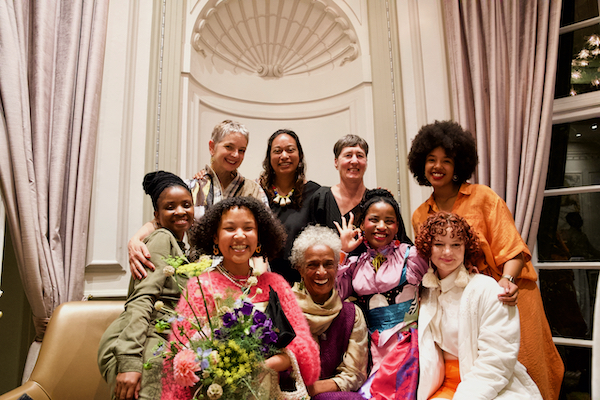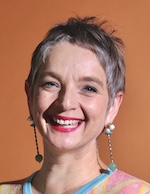Imagine kinder, fairer, inclusive, and nature-friendly futures. That’s not a question. Twyg, the online publication I founded five years ago, is in the business of imagining – as well as creating and facilitating – new futures.
Yes, it’s a plurality of futures we need to imagine, since a plurality of people with differing needs and loves needs to thrive in the future.
For most of my almost 30-year career I’ve worked on the soft, middle pages – the ones that influence what people buy, watch, eat and read. These are the pages that have been influencing our toxic lifestyles and our hyper consumption, driving global warming, and widening the gap between rich and poor.
But if these are the pages and stories that have been enticing people to buy and make fossil-fuelled cars and way too many polyester frocks, then these are the same pages that can entice people to change their behaviour.
Flipping the magazine model
Twyg’s mission is to flip the model of consumer magazine into creating inspiring and informative lifestyle stories, activations and events that drive positive behaviour change for a sustainable future.
It’s doing what United Nations Sustainable Fashion Communication Playbook recommends storytellers and imagemakers do, which is: “help portray alternative models of status and success, decoupling identity from newness and recalibrating what is deemed aspirational so as to social proof a sustainable future.”
Twyg is neatly working towards SDG 12 Target 12.8: “By 2030, ensure that people everywhere have the relevant information and awareness for sustainable development and lifestyles in harmony with nature.”
You could say that we’re part change agency, part magazine – and, like most ethical media, we work for the public good.
On a mission
Five years ago, there were very few publications on the same mission. There was Peppermint magazine in Australia and another in America called EcoCult. Nothing in South Africa, for South Africa.
Initially, the idea was to focus on all aspects of lifestyle: food, travel, fashion, film, and so on. But I quickly found that fashion was the storytelling medium that worked best for Twyg’s purpose.
Its visual appeal is good for social media, and it is a great medium to explore an entire value chain, along which there are multiple points for interrogation and storytelling.
Like food, fashion is a complex system that needs to be closely examined. Cleverly used, its visual richness can cut across social strata and provide a gateway to influence sustainable consumption, lifestyles, and wellbeing at large.
If you know anything about fashion, you’ll know that it’s riddled with pollutants and other environmentally dodgy practices.
You’ll know, too, that the clothing and textile industry was decimated by globalisation – but is flooded by extraordinarily resilient and creative talent. It involves farming, commodity markets, design, manufacturing and retail.

The retailers
There are different kinds of retailers: a handful of large clothing retailers operating in malls across the country and multiple small and independent businesses selling everything from cheap imports, street wear to hyper luxury via make-shift shops on pavement, boutiques, and Instagram.
Additionally, there is the second-hand clothing trade: the legitimate vintage stores and the illegal bale trading: a shadow fashion economy.
I got stuck in and soon I had the deceptively fancy title of founding editor of a fashion magazine when in fact I was an exhausted solopreneur of a digital start-up without a salary.
For a year I was on a mission without plan. I read, researched, learnt, failed and wrote – alone, without an editorial team to sense check my ideas and copy edit my stories. Slowly, slowly I started hiring people to work with me: mostly they found me.
Helped me grow
When I realised that the platform might have potential to impact its audience, I hired a coach to help me grow and teach me how to sustain a non-profit organisation.
The first tasks were to create an annual budget, a lean and mean Excel sheet, and some serious grant funding and sponsorship proposal writing. An initial grant for a story telling project about circular design set us up to survive Covid-19.
To help drive revenue, we launched the Twyg Sustainable Fashion Awards, and more recently, along with our Mauritian partner Imiloa Collective, we launched the Africa Textile Talks. For these, we sell sponsorship packages.
It’s a tight rope for us. We need to partner with brands who trust that we are doing the right thing for people and the planet.
Shared values
We need partners who share our values and won’t feel their corporations and organisations will be undermined by supporting fashion media that is advancing the Paris Agreement, Kunming-Montreal Global Biodiversity Framework and Sustainable Development Goals.
According to the UN, fashion communication needs to counter misinformation and greenwashing; reduce messages perpetuating overconsumption; redirect aspiration to more sustainable lifestyles; and empower consumers into their role as citizens to demand greater action from businesses and policymakers.
For organisations like ours that work on sustainability transitions, money is not readily available. What makes access to finance harder is that Twyg works at the intersection of fashion and sustainability, and not energy and sustainability. Well, not directly; all manufacturing requires energy.
First impact report
That said I’m proud about the headway we’ve made as a business, albeit an NPC. We’ve recently opened nominations for our fifth annual awards. The City of Cape Town is on board as a partner for our Africa Textile Talks, along with five corporate partners.
But I’m most proud about the findings of our first impact report, which was published in May this year. According to our survey, Twyg has caused 100% of readers to reflect on, and rethink, the impact of their lifestyle and fashion choices. It also found that Twyg’s content has taught 98% of our readers something they didn’t know before.
In an email interview about our impact, Deshayna Naidoo from the Green Cape wrote: “Twyg is the thought leader in the transition to a more sustainable and circular fashion industry.
Change in action
Through years of active knowledge engagement and dissemination, Twyg has become the first touchpoint to learn more about sustainable fashion and understand happenings in the fashion industry in Africa. Thus, Twyg plays a vital role in representing the strides made in sustainable fashion in South Africa and beyond”.
And Stefanie Swanepoel, founder and director of African Earth Rights, says, “Twyg, in its work, embodies change in action.”
What next: we feel the urgency to grow our reach to inspire and inform more people. Five years ago, we were casually concerned about global warming, now we are freaking out about global boiling. There is work to do.
 Jackie May has worked in big and medium-sized mainstream media organisations for more than 20 years. She launched Twyg in 2018. At the core of the content she publishes on the platform is a commitment to exploring ways we can live well now while ensuring a kinder, inclusive, nature-friendly future for all. When she’s not producing content for her site, she works with Refashion Lab exploring inclusive and repurposed fashion. May is a graduate of Stellenbosch University, University of South Africa and University of London. In 2020, she graduated with a PGDip from the Centre for Sustainability Transitions at Stellenbosch University. She is currently studying for an MPhil Sustainable Development.
Jackie May has worked in big and medium-sized mainstream media organisations for more than 20 years. She launched Twyg in 2018. At the core of the content she publishes on the platform is a commitment to exploring ways we can live well now while ensuring a kinder, inclusive, nature-friendly future for all. When she’s not producing content for her site, she works with Refashion Lab exploring inclusive and repurposed fashion. May is a graduate of Stellenbosch University, University of South Africa and University of London. In 2020, she graduated with a PGDip from the Centre for Sustainability Transitions at Stellenbosch University. She is currently studying for an MPhil Sustainable Development.














